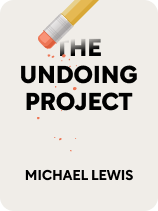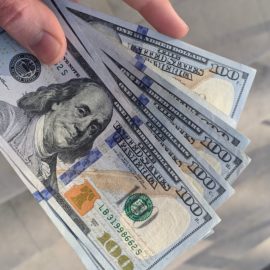

This article is an excerpt from the Shortform book guide to "The Undoing Project" by Michael Lewis. Shortform has the world's best summaries and analyses of books you should be reading.
Like this article? Sign up for a free trial here.
Do you understand why you make the choices you do? How prone to error is the human mind?
Thanks to the groundbreaking research by two Israeli psychologists, Daniel Kahneman and Amos Tversky, we can get at the answers to these questions. Their collaboration produced ideas that reshaped the way psychology understands the mind.
Keep reading for an overview of The Undoing Project by Michael Lewis.
The Undoing Project by Michael Lewis
The story of Tversky and Kahneman’s lives, told in The Undoing Project by Michael Lewis, is as riveting as the truths they uncovered. On the surface, the two men couldn’t have been more different. Kahneman was reserved and given to self-doubt, while Tversky was brash, outgoing, and magnetic. Yet both had a deep interest in the workings of the mind and were insightful, inquisitive thinkers with a knack for seeing flaws in ideas that everyone else took as given. They identified systematic ways the mind fools itself, why we make irrational decisions, and how we reshape reality when the truth is too painful to bear. By making us aware of our mental fallibility, Kahneman and Tversky gave us the tools to sharpen our thinking and avoid the pitfalls of unconscious bias.
The author, Michael Lewis, first rose to popularity with his book Moneyball about the use of statistical analysis in major league sports. While that book was a hit, Richard H. Thaler and Cass R. Sunstein (co-authors of Nudge and Noise) pointed out that the science Lewis referenced came out of the work of Kahneman and Tversky. When Lewis looked into the psychologists in question, he found a whole new story that needed to be told.
The first part of this guide will examine the collaboration of Tversky and Kahneman, with a focus on how their personal experiences led to the paths they took in their research. In the second part, we’ll explore the three major theories formulated from their work: heuristics, prospect theory, and the concept of undoing.
A Revolutionary Duo
In psychology, Michael Lewis suggests that the quintessential duo was Daniel Kahneman and Amos Tversky. As individuals, they were unconventional thinkers, but together they amplified each other’s strengths, allowing them to upend behavioral psychology and change the way we understand the foibles of the human mind.
Daniel Kahneman
Daniel Kahneman was a Holocaust survivor who, from an early age, developed an interest in human behavior, particularly in our capacity for error. Though born in Tel Aviv in 1934, Kahneman grew up in Paris and was there for the outbreak of World War II. His father, like many others, misjudged how far the Germans would penetrate France. Later in life, Kahneman would explain this error as a function of the availability heuristic.
Kahneman and his family fled to the south, where they hid their existence as Jews. It was there, Lewis says, that young Kahneman became a student of other people’s behavior, which he quietly watched as an outsider. His father died before the war ended, and Kahneman’s family moved with many others to the future state of Israel in 1946.
A vocational test pointed him toward psychology, and, while service in the Israeli army was mandatory, Kahneman’s grades were high enough that, in 1951, he was allowed to go directly to college before having to join the armed forces.
Kahneman went to Hebrew University. Because the school was still piecing together its psychology curriculum, Lewis claims that Kahneman essentially had to educate himself.
According to Lewis, the leading field of psychology at that time was Behaviorism, the study of mental conditioning through stimuli and rewards. Kahneman, on the other hand, was drawn to Gestalt psychology, which suggested that the mind acted as an interpreter between external stimuli and internal perceptions.
Upon graduation in 1954, Kahneman joined the army and, as the military’s only psychologist at the time, was assigned to evaluate new enlistees. He noted that the people interviewing recruits were falling victim to the “halo effect,” in which their first impressions colored all following judgments of a candidate.
According to Lewis, Kahneman decided to remove human judgment entirely from the process, developing an evaluative “Kahneman score” based on new recruits’ documented behavior rather than faulty human perceptions. He found that his department’s evaluations improved.
In 1961, Kahneman earned his doctorate from UC Berkeley and began his postgraduate research at the University of Michigan. There, Lewis says, he discovered a conflict between the thinking mind and sensory perception. Returning to Hebrew University, he continued his research into human vision by focusing on what it failed to perceive and how it could be tricked.
Amos Tversky
Amos Tversky was born in Haifa in 1937. In between high school and college, he volunteered as a paratrooper and fought in the war of 1956. Once he was able to attend Hebrew University, Tversky studied psychology, though, according to Lewis, he began to feel that much of its research was unscientific. However, his interest was sparked by a research paper that put forward the process of making decisions as a field for study. Intrigued, in 1961 Tversky enrolled in the Ph.D. program at the University of Michigan, which boasted the world’s premier psychology program.
Lewis points out that, until then, decision-making had been studied by economists who assumed that people made choices rationally. An implication of this belief was the transitive nature of preference. However, Tversky’s research showed that preferences are intransitive.
Tversky hypothesized that people make judgments based on “features of similarity,” only taking into account the features that they happen to notice. Lewis points out that Tversky’s approach solved the intransitivity problem by asserting that the features people use to make decisions are dependent on context. Tversky’s ideas also predict what’s known as the framing effect—the principle that decisions can be manipulated by reframing the context in which they’re made.
This work began the pattern that Lewis asserts would define Tversky’s career—he would examine widely held scientific beliefs, find chinks in their armor, and take them apart.
While pursuing his research, Tversky married psychologist Barbara Gans in 1963. He earned his doctorate in 1965 and returned with his wife to teach at Hebrew University, but shortly after, he was called back to duty to command an infantry unit in the war of 1967.
The Collaboration Begins (1969-73)
According to Lewis, Kahneman’s understanding of the fallibility of perception mixed with Tversky’s persistent questioning and mathematical rigor let them demolish the common assumption that human thought is based upon reason.
Though they were colleagues at Hebrew University, their first real interaction took place in 1969 when Kahneman invited Tversky to speak at one of his classes. Tversky discussed research that showed that humans were unconscious statisticians—that guesses people made roughly matched up with mathematical statistical predictions.
Kahneman disagreed. He knew from his research that the senses could be fooled. Why not the mind as well? Lewis recounts that Kahneman argued strongly with Tversky, citing the various cognitive errors he’d seen his own students make. Tversky was troubled by the doubt he introduced, but, instead of becoming antagonistic, the two psychologists chose to join forces and test whether the subconscious uses statistics to make judgments.
To investigate their problem, they devised a questionnaire that would pose an array of statistical questions purposefully designed to trip up the people being tested. Instead of inflicting their questionnaire on hapless students, Tversky and Kahneman took it to professional statisticians. The statisticians should have answered the questions correctly, yet they didn’t. What’s more, Lewis claims, the mistakes made by trained statisticians were consistent across the board. Chief among these was what Kahneman and Tversky dubbed “The Belief in the Law of Small Numbers,” a cognitive error in which a person assumes that a small sample of information is representative of a larger whole.
According to Lewis, Tversky and Kahneman’s paper on the subject called into question the bulk of social science research because, when conducting surveys across populations, social scientists vastly underestimated the number of participants needed to provide meaningful data.
Meanwhile, says Lewis, a body of evidence was growing that even expert opinions were marred by faulty thinking. Scientists at the Oregon Research Institute began to study how experts actually drew their conclusions, as opposed to how they claimed they did. In 1970, Tversky went there to further his work, while Kahneman continued his research at home in Israel.
The Birth of Heuristics
In America and Israel, the pair of psychologists presented students and children with a battery of oddball statistical problems. They wanted to study how they got them wrong. Kahneman and Tversky reconvened in Oregon in 1971 to sort their data.
They found that the mind does not calculate statistics. Instead, it applies rules of thumb that Kahneman and Tversky dubbed “heuristics”—mental models that break down in problems that contain random elements.
Lewis asserts that, by studying the ways in which the mind fails, Tversky and Kahneman revealed how it works. They discovered that people, even experts in their fields, rely heavily on stereotypes and ignore statistics.
The Duo in Action (1973-1977)
By 1973, Kahneman and Tversky were ready to summarize their findings but, once again, war intervened in their lives. The following military conflict gave fresh urgency to the problem of uncovering the foibles of the mind. Lewis writes that, in the years following the 1973 Yom Kippur War, Kahneman and Tversky were particularly troubled by their government’s failure to predict the attack. They shifted their focus to examining the decision-making process and gave birth to a theory that overturned our understanding of human behavior in general.
Decision-Making and Prospect Theory
In order to stave off a similar surprise attack in the future, Kahneman and Tversky tried to convince the country’s policy makers to calculate probabilities and play the odds. However, hey learned that generals and leaders always favor their instincts. Lewis says this led Tversky and Kahneman to conclude that people need stories, not numbers.
Lewis writes that prior studies of decision-making revolved around hypothetical gambles. The reigning explanation for how people made decisions was expected utility theory—the idea that people are rational actors who calculate the utility of a situation to make the optimal decision. Swiss mathematician Daniel Bernoulli introduced the idea that people also calculate the psychological value of outcomes. Tversky and Kahneman were of the opinion that decision-making was far more chaotic.
Tversky and Kahneman decided that emotions, not just probabilities and economic value, must be taken into account. The emotion Kahneman latched onto first was the anticipation of regret. Bernoulli’s risk aversion, then, can be seen as the price of avoiding regret. However, they still couldn’t understand what prompted people to make risky decisions. Tversky and Kahneman found that people are much more open to taking risks if it means avoiding loss instead of making gains.
In 1975 they worked together on creating “risk-value theory,” also known as “prospect theory,” which balanced human decisions based on gains and losses and laid bare the patterns of seemingly irrational human behavior. At the time, economics theory asserted that the irrational errors people made were random and would be corrected by the market. Prospect theory, however, showed that humans are irrational in consistent, systematic ways, and that irrationality is built into the economic market itself. In other words, according to Lewis, prospect theory was the iceberg that could sink all of the prevailing economic thought.
Separate Ways (1978-1996)
Lewis claims that Kahneman and Tversky’s newfound stardom in the academic world, coupled with changes in their personal lives, put their partnership on tenuous ground that affected them both in different ways. Their relationship shifted through the 1970s and ’80s such that Tversky received more and more credit, while Kahneman began to feel resentful of his partner’s antagonistic style until he felt they could no longer work together.
In 1978, Kahneman settled at the University of British Columbia, while Tversky took a posting at Stanford. Their partnership would now be conducted long-distance.
Undoing Theory and Public Perception
Kahneman had observed that people experiencing grief try to “undo” the pain of a tragedy by dwelling on what might have happened to prevent it (hence the term Undoing). Tversky contributed some material to the project.
Lewis makes it clear that Tversky rebuked anyone who painted him as the more important of the pair. Nevertheless, he was the one whom other academics came to for insights on how prospect theory related to their work.
Throughout the ’80s, they continued to publish papers jointly, though each was written mostly by one and not the other. Their work also began to be attacked by academics whose research they’d thrown into question. Some challenged prospect theory in particular, while others rejected Kahneman and Tversky’s basic premise that human beings are fundamentally irrational.
Conflict and Tversky’s Death
Lewis writes that Kahneman’s impulse was to avoid conflict, whereas Tversky wanted to go on the warpath. He pushed Kahneman to coauthor a paper that would show conclusively that the mind ignored logic. Their paper was published in 1983.
In 1986, Kahneman took a position at UC Berkeley, only 40 miles from where Tversky worked at Stanford. But, being in such proximity made Kahneman so unhappy that, in 1992, he left California for Princeton. Lewis says that Kahneman considered their partnership over, but Tversky reached out in 1993 to cajole him into writing one more paper responding to a critic, Gerd Gigerenzer. The process of crafting their reply was so contentious that for Kahneman it not only ended their collaboration, but it also marked the close of their friendship.
Almost immediately afterward, Tversky was diagnosed with terminal cancer. Lewis recounts that Kahneman was one of the first people Tversky reached out to, and, though Tversky faced his death with peace and stoic calm, his mortality reminded Kahneman of the value of their friendship. Tversky and Kahneman spoke nearly every day until Tversky passed away in June 1996.
Lewis writes that, after Tversky’s death, Kahneman finally began to receive the attention and acclaim he’d been denied, culminating in a Nobel Prize in Economics in 2002 and the publication of his seminal work, Thinking, Fast and Slow, in 2011.
Three Major Breakthroughs
Lewis shows that, between 1969 and 1979, Kahneman and Tversky overturned our understanding of how we make decisions, not once, but three times. We’ll explore each of these ideas.
The Theory of Heuristics
Kahneman and Tversky’s first breakthrough was determining that, when making judgments, the mind doesn’t unconsciously calculate statistics, as was the common belief of the time. Instead, the mind applies stories and stereotypes through processes that Tversky and Kahneman called heuristics. In short, our minds use a variety of shortcuts to make guesses when we don’t have enough information.
In their research, they identified three separate heuristics that systematically cloud human judgment:
- The representativeness heuristic describes the way our minds persistently compare people and events to stereotypes and other assumptions based on past interactions.
- The availability heuristic states that you will consider any given scenario more likely if you can easily recall a similar situation.
- The anchoring heuristic relates to how the mind deals with numbers. Tversky and Kahneman found that, when asking test subjects to estimate numbers, their guesses could be manipulated by “priming” their subjects with irrelevant information.
The Theory of Risk
Whereas economists approached the problem of risk strictly in terms of financial gain, Lewis writes that Tversky and Kahneman took a broader tack and discovered that people are far more influenced by the desire to avoid potential loss. Their “prospect theory” explains why we take risks, how we define loss, and how our choices can be influenced by the way risks are presented. People dislike losing what they have far more than they enjoy getting what they want.
Kahneman and Tversky found that people are risk-averse when considering gains, and more risk-taking when facing a loss. Therefore, Lewis says, our judgments can be manipulated depending on whether our circumstances are framed as positive or negative in relation to our perceived status quo.
“Framing,” it turns out, is a powerful tool that can be employed by businesses marketing goods, politicians swaying votes, or doctors persuading patients to have surgery. Lewis relates that Tversky and Kahneman’s results led to an axiom—we don’t choose between options; we choose between how those options are described.
The Theory of Undoing
Tversky and Kahneman uncovered a fourth heuristic of the mind, one in which we create alternate realities to avoid the pain of tragedy and frustration.
Lewis says they named their new mental model the simulation heuristic, referring to the power of “what might have been” to cloud present-day judgments and decision-making. Imagining an alternate, happier life offers a temporary salve to feelings of sorrow, but it also contaminates our perception of reality by evoking feelings of envy and regret for paths not taken.
Kahneman dubbed the process of rewriting painful events “undoing,” which he interpreted as a coping mechanism to deal with life’s infinite possibilities. Lewis states that, in their research, Kahneman and Tversky established four rules the mind follows when undoing the past:
- The more separate events we have to undo at once, the less likely we are to do so.
- The farther events retreat into the past, the harder they become to undo.
- In undoing, we imagine a person making a different choice, and not merely a different random circumstance.
- In undoing an event, we tend to disregard any unexpected aspect of what occurred.
Because of the process of undoing, Tversky observed that, for the mind, reality isn’t fixed. Instead, it’s a haze of possibilities.

———End of Preview———
Like what you just read? Read the rest of the world's best book summary and analysis of Michael Lewis's "The Undoing Project" at Shortform.
Here's what you'll find in our full The Undoing Project summary:
- The mental errors that skew your daily decisions
- How to avoid the unconscious pitfalls of the mind
- How Daniel Kahneman and Amos Tversky formed their famous partnership






